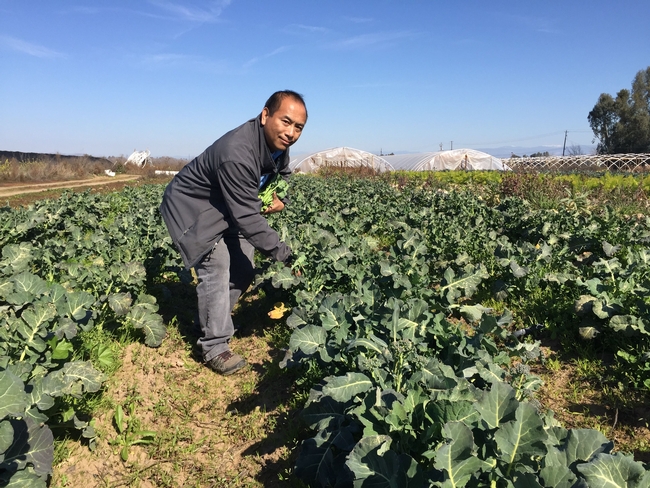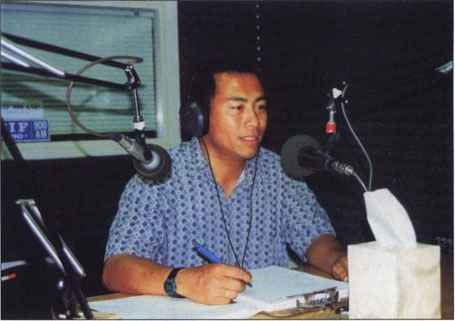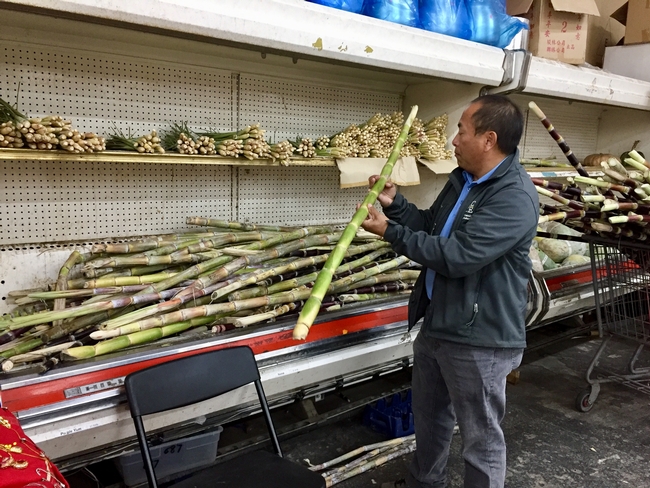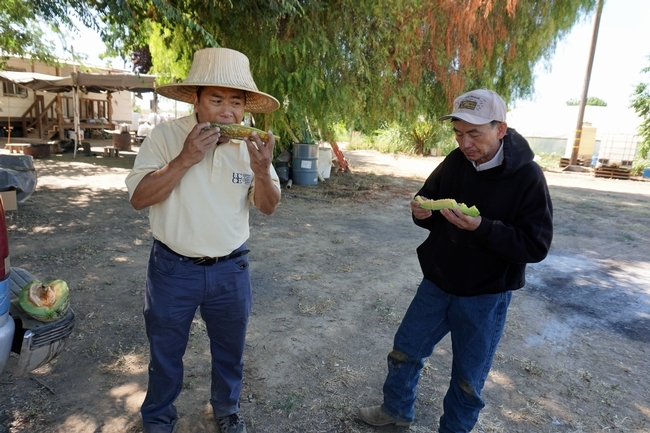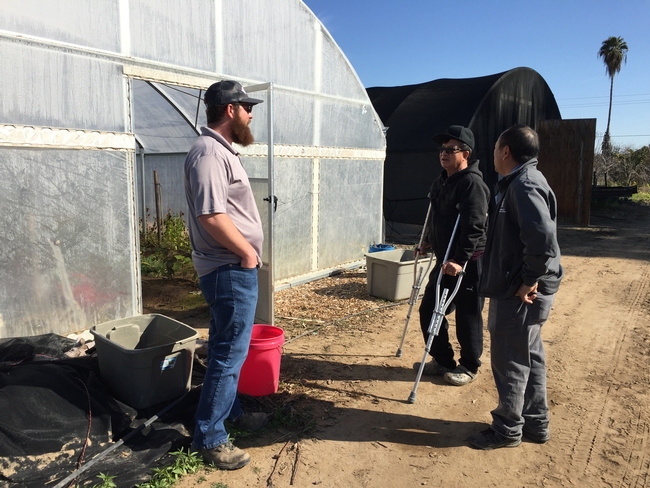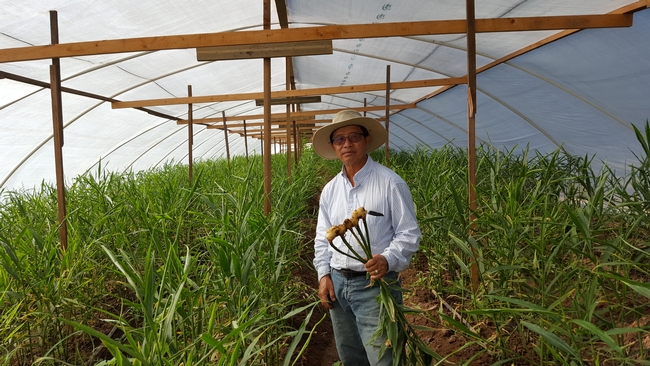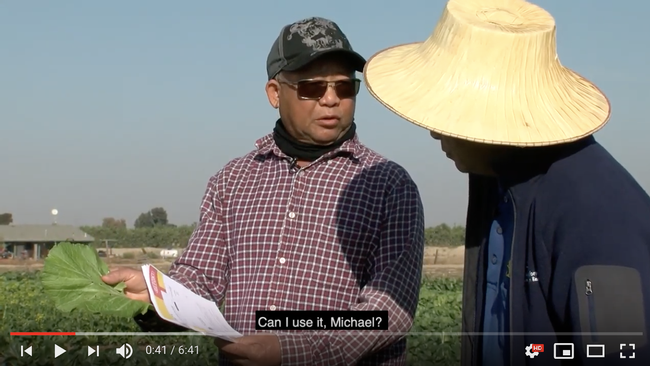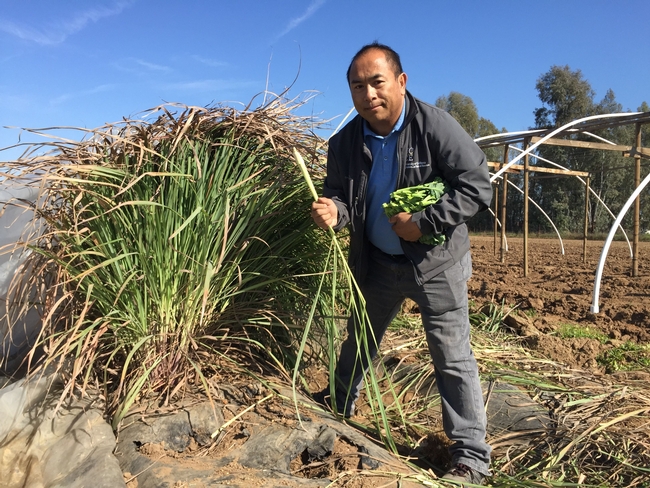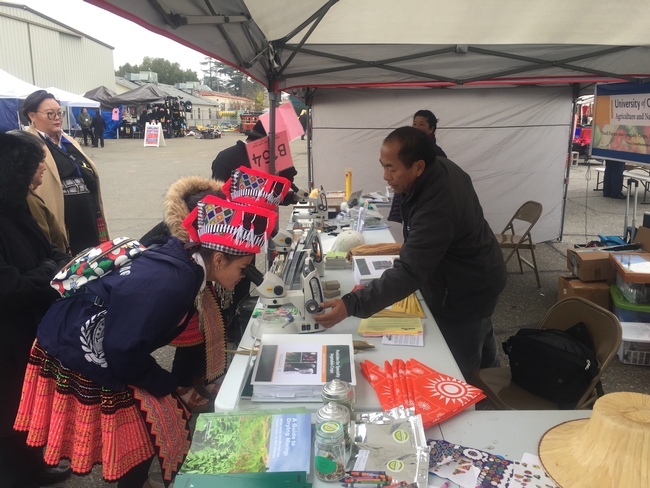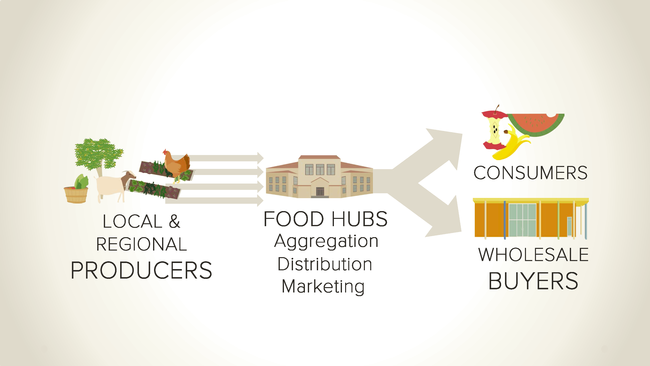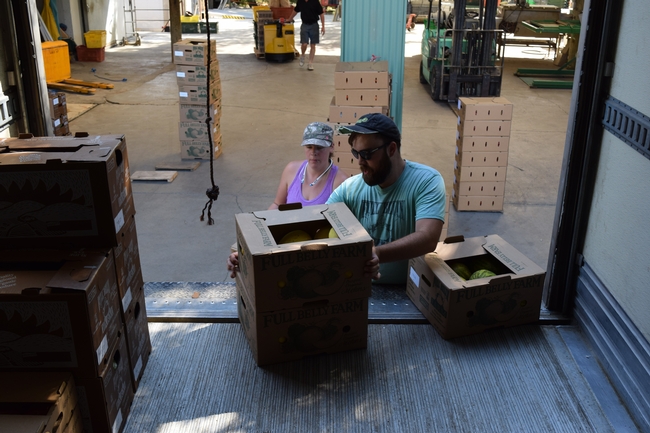
Posts Tagged: small-scale
In person and over the airwaves, Yang strives to help Hmong farmers prosper
This is the third in a series featuring a few scientists whose work exemplifies UC ANR's public value for California.
Keeping current on government regulations, agricultural marketing news and crop research advances can be challenging for California farmers, especially for those who speak English as a second language.
Hmong farmers in the San Joaquin Valley can tune in at 2 p.m. on Tuesday afternoons to listen to farm-related news delivered to their radios in their native language from Michael Yang, UC Cooperative Extension small farms and specialty crops agricultural assistant for Fresno County.
For the past 22 years, Yang has hosted the one-hour Hmong Agriculture Radio Show on KBIF 900 AM in Fresno to promote prosperity in the largely immigrant, small-scale Southeast Asian farming community. Yang provides advice on crop production and marketing.
“Fresno County has a large number of small and diversified farms; we have over 1,300 Southeast Asian farms and over 900 are Hmong farmers, according to a survey we did in 2007,” Yang said. “I used to help 250 to 300 farmers every year, in the past couple of years it's grown to about 400 farmers.”
Yang not only speaks their language, he shares their culture and history. After his father was killed for assisting the U.S. during the Vietnam War, Yang, his mother and three younger brothers spent 4 years of his childhood fleeing on foot through the jungles of Laos, subsisting on vegetation and wildlife, to reach safety in Thailand. The refugee family eventually made it to Fresno, where they took up farming.
The Hmong farmers grow Asian specialty crops including eggplant, lemongrass, long bean, squashes, bittermelon and moringa that they sell at farmers markets or to restaurants. Connecting Southeast Asian farmers to sell their produce at farmers markets has been a vital role for Yang, who serves as a translator and cultural interpreter between the immigrant farmers and farmers market managers. He explains the requirements for participating in the farmers markets and helps the farmers with paperwork and communication. Some growers drive as far as San Diego to get a higher price for their produce; the price can be three times as high at farmers markets in larger cities compared to Fresno.
Sales of Asian specialty crops grown by Hmong and other Southeast Asian farmers in Fresno County are valued at about $17.5 million annually, according to the Agricultural Commissioner of Fresno County.
Although Yang and colleague Ruth Dahlquist-Willard, UC Cooperative Extension small farms advisor, offer workshops and field days to share information, the radio show is an important information source because farmers can listen to the show while they work in the field. Because Hmong Agriculture Radio Show is such a critical tool for bilingual outreach, Dahlquist-Willard continually seeks grants to pay the $75 per show to the radio station. Of the 69 Hmong farmers who responded to a 2015 UC Cooperative Extension survey, 80% said they regularly listened to Yang's radio show.
“With the help of our Hmong Agricultural radio outreach, I have Hmong farmers calling our office for assistance from Tulare County up to Stanislaus County,” Yang said.
In 2015, during the drought, Yang and Dahlquist-Willard began helping desperate farmers who were running out of irrigation water.
“Wells were starting to dry up. Some Hmong farmers were reportedly calling suicide hotlines,” Dahlquist-Willard recalled. “For the ones with dry wells, it could cost $20,000 to $50,000 to drill a new well.” That is money that most of the farmers, who typically cultivate less than 50 acres, didn't have.
Eighty-seven percent of the Hmong farmers said their utility bills had risen during the drought. Yang, Dahlquist-Willard and Xai Chang, a young Hmong farmer working with UCCE, helped the farmers get a free PG&E rate analysis, which could help the farmers choose the best electric rate for their irrigation practices to lower the expense. The UCCE team also searched for financing to deepen wells for farmers who had difficulty qualifying for USDA loans and helped them apply for grants from the State Water Efficiency and Enhancement Program. With additional help from small farms assistant Jacob Roberson, the UCCE small farms team in Fresno has assisted 36 small-scale Hmong, Latino, and African-American farmers to implement SWEEP projects on a total of 846 acres. The small-scale growers have used SWEEP dollars to invest in technologies like energy efficient pumps, drip irrigation systems and flow meters to save water and reduce their energy costs.
“Michael helped me get a grant to buy a new pump for drip irrigation,” said Xiong Pao Her, who grows about 100 crops throughout the year – including ginger, broccoli rabe, fennel, garlic, green onions, napa cabbage and kale – in Sanger. “It saves me water.”
Obtaining land to farm can be difficult for small-scale farmers so the UCCE agricultural assistant connects farmers looking to rent land with landowners, and serves as a bridge for the language and cultural gaps between the two, according to Dahlquist-Willard.
“There was an elderly couple and their daughter wanting to rent land to a Hmong family, and Michael sat down at the table with all the parties and helped them work out a lease agreement, such as requirements for liability insurance,” she said. “Land isn't as available to rent as it used to be, but when it was, Michael would get frequent calls from landowners asking if he knew any farmers who would be interested in renting their land. The number of Southeast Asian farmers who have had a successful lease agreement or a successful farmers market stand because of Michael's help is probably very large.”
Recently Yang and Dahlquist-Willard partnered with California State University Fresno to produce a pesticide-safety video series for the California Department of Pesticide Regulation. “We hope the videos help more farmers understand pesticide regulations and avoid fines, as well as improve their safe handling, selection and effectiveness,” said Yang.
It's not the first time Yang, who has been working for UC Cooperative Extension since 1993, has helped farmers navigate government regulations. Between 2005 and 2008, individual Hmong and Hispanic farmers were being fined between $14,000 and $26,000 for noncompliance with state labor regulations. To provide farmers with a clear understanding of the labor laws, Yang and Richard Molinar, then UCCE small farm advisor, partnered with a variety of community organizations to present information to farmers in English, Spanish, Lao and Hmong at community meetings, on the radio and television, and in trade magazines and newspapers.
“Without the support provided by the UCCE, hundreds, if not thousands, of Hmong farmers would have been added to the victim list for not knowing or understanding the laws. The UCCE has gone many extra miles to fill gaps between enforcement agencies and the Hmong farming community,” Toulu Thao, a Hmong activist, said at the time.
To help farmers decide which crops are most profitable to plant, Yang collaborated in the past with UC colleagues to estimate production costs for some Asian vegetables including sinqua, moqua, opo, longbean, bittermelon, oriental eggplant and lemongrass.
Yang currently advises Hmong growers on about 200 crops and continues to learn about new ones as farmers market customers ask the growers to produce fruits and vegetables from other cultures.
#Collabatition: A new network of food hubs looks past competition to help each other succeed
In today's food system, large scale food distribution has become the standard way food moves from farm to market. The system works well to feed a lot of people, and has allowed us to eat tomatoes in December and send produce far distances while keeping it fresh. But the system is not without its sacrifices.
Through large scale food distribution, farmers can lose the ability to set their own prices, and small-scale farmers can be cut out from the system for not being able to fill high volume orders. On the consumer side, this system can make local food harder to find and identify. Institutions interested in providing locally grown produce at their cafeterias may need the efficiency buying from large distributors provides, but find they're unable to source food the way they'd like.
Food hubs are businesses popping up around California and the U.S. trying to create a food distribution system that supports regional food systems. By aggregating food from small and mid-sized farms and selling it to large businesses and institutions, food hubs are able to help realize the consumer's desire for local food while helping small and mid-sized farmers succeed by connecting them with buyers who may otherwise be out of reach.
To help ease the challenge of starting these unique businesses, a network of food hubs in California, organized by the UC Sustainable Agriculture Research and Education Program, is learning how to conquer their business start-up and growth challenges together.
Food hubs as business innovators
Thomas Nelson, president and co-founder of Capay Valley Farm Shop, a food hub in California's Capay Valley, has built his business around a vision of a thriving regional food system where small farmers succeed. Thomas purchases food from 50 different farms in and near the Capay Valley, and sells primarily to corporate food service in the Bay Area.
“Our model is farmer-focused," Thomas said. “Farmers set the price for their food, and we add on our margin. We help tell the story of the farms so that their identity is kept throughout the supply chain. We let our buyers know about new products or new farms we're working with, and our buyers ask for produce by farm name.”
Thomas works closely with his 50 farmers, helping them plan their crops to best meet the demands of their clients, and working with the beginning farmers to get them through the hurdle of learning how to sell wholesale.
“It can be a challenge to accurately predict the next harvest,” Thomas said. “And it's our responsibility to mitigate some of those risks for the buyers as much as possible, but our buyers also get it. The reason they choose to work with the food hubs is they want to support local farms. What really makes this work are shared values.”
#Collabatition
Thomas is one member of a new statewide food hubs network created in collaboration with the UC Sustainable Agriculture Research and Education Program (UC SAREP), a statewide program of UC Agriculture and Natural Resources whose work includes improving marketing opportunities for small farmers. The network, funded in part by the UC Global Food Initiative, brings together food hub mangers to learn from one another and collectively pave the way for successful food hubs in California.
The food hub business model is a relatively young one, few food hubs existed in the United States before 2008. Today, hundreds are in business across the country, and they're all trying to figure out similar things: how to best work with farmers and customers to make the business model effective, how to run a food business in a regulation-laden environment, how to increase efficiency without sacrificing price, quality, and the value of local agriculture.
“Food hubs are really working with farmers in their local areas to help them reach markets beyond selling directly at the farmers' market,” said Gwenaël Engelskirchen, who leads the food hub projects at UC SAREP. “We brought a group of northern California food hubs together for their first convening in February of 2015 and they realized that they all had a lot to learn from each other. They realized that there's opportunity in them working together.”
There's a hashtag on Twitter for what they're doing: #collabatition, or, collaborating with your competition. UC SAREP acts as the organizing body for the food hub network — coordinating resources to help the hubs wade through the many rules and regulations of operating a food business, and working through the visions of their own businesses and the network collectively.
“This is a newish space, so there is a ton to learn and share,” Thomas said. “By having a network we are supporting each other on the journey of growing successful businesses that serve local farms and regional buyers. Working with UC SAREP, we can have conversations with larger buyers that would be hard for us independently to access.”
One of those potential larger buyers is an organization close to home — the kitchens of the University of California.
“UC SAREP plans to interview kitchen directors from UC campuses all around the state to see what keeps them from buying local food, and whether the food hub business model is one that can support the desire they have to incorporate local food into their kitchens,” Gwenaël said.
And past successes show that food hubs can play an important role in linking UC dining programs with local farms. According to a recent report from the UC Global Food Initiative, through a relationship with the food hub Harvest Santa Barbara, UC Santa Barbara is currently able to source 23 percent of its produce from within 150 miles of campus.
“By linking UC food buyers with food hubs, we want to see if that success can be replicated around California," Gwenaël said. "In 2014, UC Santa Barbara alone served nearly three million meals, so the entire UC becoming a local produce buyer could be a major boon to regional food systems.”
The UC SAREP website offers a number of resources that can assist food hubs as well as farmers looking to see their produce wholesale. Find those resources here. Stay tuned for an upcoming article on food hubs in the next issue of California Agriculture journal.
Small-scale farming and urban animal agriculture survey
The following comes from Dr. Alda Pires at UC Davis. Please consider participating in the survey.
Survey to identify the needs of small-scale farms and Urban animal agriculture Producers in the Western States of the US: livestock and poultry owners
The growing numbers of small-scale farms (SSFs) (1) and peri-urban and urban animal agriculture farms (UA) has increased the need for Extension specialists and veterinarians focused on small-scale and backyard livestock production(2). We are seeking your help in this needs assessment regarding animal health concerns on small-scale farms and for peri-urban and urban animal agriculture in California, Colorado, Oregon, and Washington State. This study is led by Dr. Alda Pires (University of California), Dr. Dale Moore (Washington State University) and Dr. Ragan Adams (Colorado State University).
The increasing popularity of local food production and sustainability has put small-scale farming and urban animal agriculture at the forefront. Your input is very important in better understanding this food sector and would be greatly appreciated.
This survey aims to identify the needs of livestock and poultry owners related to animal health, animal husbandry and food safety; and the role that veterinarians play on small farms. This study will serve as a benchmark for designing effective educational programs to train farmers, backyard producers and veterinarians working within this sector.
Your participation is essential for this needs assessment. The survey will take about 15-20 minutes of your time. The survey can be accessed here:
http://ucanr.edu/survey/survey.cfm?surveynumber=15917
All your answers will remain completely confidential and no personal information about you will be recorded. You have the option to not participate and you can quit the survey at any time. This project is approved by the UC Davis, WA and CO University Institutional Review Boards.
We thank you for your time and your commitment to small-scale farming and urban animal agriculture.
Should you have any questions at any time, please feel free to contact me directly (Alda Pires at 530 754 9855, apires@ucdavis.edu).
Greenhouse Sowing in the HEAT of Summer
Most of us have built our greenhouses to create warm places to start our seeds and grow our seedlings when the weather outside is cool. In a region that has seen snow on Memorial Day Weekend, the winter-time greenhouse is critical to establishing plants that are ready to go in the ground once the danger of frost has passed. But by July, these same structures can become oppressively hot in the heat of the day rendering them useless for plant propagation.
The vegetables and flowers that can over-winter in our region germinate, in general between 70 and 85° Fahrenheit. (There are a couple of exceptions, such as cabbage, which will germinate at temperatures as high as 95°F.) Starting these seeds in a hot greenhouse during August is a bad idea. Though some seeds may germinate, you will need to spend a lot of time watering and the risk of drying out your seedlings is very high. Check out the “Knotts Handbook for Vegetable Growers” for more information on germination temperatures and requirements (http://extension.missouri.edu/sare/documents/KnottsHandbook2012.pdf.)
A simple solution is to start your seeds outdoors. Yep, that's right- outdoors. Just move a few greenhouse benches outside (in a deer protected area) and start your seeds there. If temperatures remain in the high 90's, you may want to consider starting your fall starts in an area that receives afternoon shade. Seeds will readily germinate and seedlings will grow well adapted to the outdoor weather.
The larger the cell size, the slower the dry down. Try and use larger cells if you don't want to water multiple times a day. You will use more potting mix, but may be able to get away with one, well timed, thorough watering. If you are struggling to find time to water adequately, think about installing a simple, automated system. A battery operated, spigot timer can be purchased in most hardware stores and a “low-flow,” rotary sprinkler will emit small droplets that won't damage freshly seeded trays. Pound in a t-post and zip-tie the sprinkler to the top for a quick and dirty watering system. An online search will yield many options for a more advanced greenhouse watering system.
Another greenhouse cooling option is to place shade cloth over the plastic of your structure. Shade cloth is a knit polyethylene fabric that can be stretched over a greenhouse or hoop-house. It is reusable and available in densities from 30% shade up to 90% shade. A study by North Carolina State University showed that lower density shade cloth was as effective as higher density at keeping temperatures cooler (https://www.uvm.edu/~susagctr/resources/HighTunnels.pdf.) This is useful information considering the cost of shade cloth increases along with its density.
Whether you start your seeds in a well-ventilated, shaded greenhouse or outdoors, the main thing is to to keep temperatures and moisture levels optimal for seed germination. In the foothills, you'll want to have over-wintering plants in the ground by the end of September so if you haven't started your seeds yet, now is the time to do it!
Project fosters connections between farmers and food buyers
The 100 miles between the agricultural fields that surround Davis, Sacramento and the Sierra Foothhills and the culinarily rich city of San Francisco can seem vast to farmers who lack the connections needed to market their produce to Bay Area buyers.
That gap was bridged this week for a group of 25 small, beginning and ethnic farmers when the Agricultural Sustainability Institute (ASI) at UC Davis and the Sacramento County UC Cooperative Extension hosted a day-long bus tour that began in Sacramento early Tuesday morning. Farmers boarded a bus bound for the Bay Area, where they met wholesale food buyers.
“Many buyers are eager to meet small-scale farmers who can supply the rapidly expanding market for locally grown food,” said David Visher of the Agricultural Sustainability Institute at UC Davis.
Emma Torbert of Cloverleaf Farm was pleased to find that to be true.
“It was nice for farmers to hear how much interest there is in San Francisco,” she said. “It can be nerve-racking to try to sell something to someone you don’t know. This was great, because the tour created an environment to talk about this sort of thing.”
Doors into the Bay Area market have already opened for Emma.
“I’ve had people calling me back already to buy my produce,” she said.
Interest in locally produced food is growing nationwide, according to Gail Feenstra of the UC Sustainable Agriculture Research and Education Program, a program within ASI.
“Food is an important part of our concept of community. People want a relationship with local growers because their food nurtures us. They feed our sense of community and also steward the land in our region. I think people are searching for ways to connect around food because it benefits our personal, economic and environmental health.”
As the group headed west toward their first stop at the San Francisco Wholesale Produce Market to hear from various buyers, Visher and fellow tour organizer Chuck Ingels, a UC Cooperative Extension farm advisor and the interim county director for Sacramento County, shared a food safety/ self audit CD created by UC Cooperative Extension. The project staff also helps farmers create an action plan for marketing their produce and works with them one-on-one to write a profile about their farm.
“We can help growers tell their stories and make good-value propositions to buyers, but it’s really up to these business people to make their own deals,” Visher said.
The institute, Laura Tourte, a UC Cooperative Extension farm advisor for Santa Cruz County, and Santa Clara County Farm Advisor Aziz Baameur will host a second tour Tuesday, Nov. 5. Farmers on Tuesday’s tour will leave for San Francisco from Watsonville at 5:15 a.m. and San Martin 6:15 a.m. The group will visit a wholesale distributor, food hub, distribution/processing facility, grocery store and Stanford dining services, where they will have lunch.
The Small Ethnic Farmer Tour Project is funded by CoBank, a national cooperative bank, and three farm credit associations: Farm Credit West, American AgCredit, and Farm Credit Services of Colusa-Glenn.
To register for the tour out of Watsonville and San Martin call (831) 763-8040 or email cesantacruz@ucdavis.edu. Space is limited. There is a $20 fee to hold a space on the tour. That fee is fully refunded upon boarding the tour bus. Spanish language translation is available.
SC Tour Agenda

Bill Fujimoto Diablo Foods (3)

